
Standing on the platform of Hong Kong’s Tsim Sha Tsui station at 11:30 on a Tuesday night, watching crowd after crowd filter into already busy subway trains, you come to understand the importance of the MTR to the city pretty quick. On top of being one of the world’s most densely populated cities, Hong Kong’s geography (a crowded island separated by a busy harbour from a mountainous territory) poses unique problems to transportation planners. Mix this with a political climate that some claim to be amongst the most neoliberal in the world (the Hong Kong government moved heavily in the 90’s to divest itself of public utilities), and you have a very unique and fascinating transit system that is a hot bed for innovation.
The backbone of the system is clearly the MTR subway and rail system. The first line of which opened in 1979 and has since expanded to cover over 211km with 150 stations; although some of this expansion was accomplished through a takeover of the existing Kowloon Canton Railway (KCRC).
The subway is marked by several features, most notably its utilitarian design. Similar to Toronto, many stations are colour coded for easy recognition. Public art is not particularly common and food and drink is banned from the fare paid area. Glass barriers separate the platform from the track at all stations, and give the platform itself a much more comfortable and enclosed feel. The most noticeable characteristic of the system however is the ever-present crowds. This hits home the fourth and fifth time you hear the trilingual announcement reminding people to stand clear of the doors.
Crowd control is built into the system’s design and impressive infrastructure works to reduce bottlenecks. At some prominent transfer point between lines tracks are interchanged over two stations so that passengers can disembark and simply cross the platform to the other line, depending on which direction they want to go.
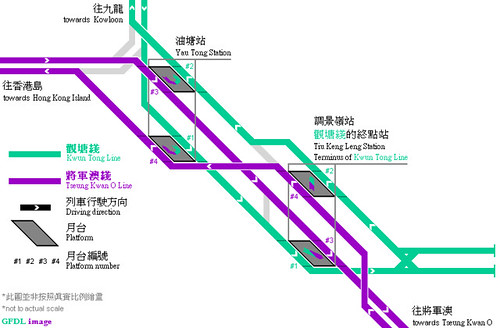
Diagram showing a two station interchange on the MTR, busy transfer points were anticipated in the design and are often at level
The MTR is a full of interesting details. Displays in many stations narrate the history of the area while guard rails around escalator entrances ensures orderly crowds when leaving stations. An admirable system of exit signage in mezzanines matches above ground destinations to exit letters and sub numbers. Each exit/entrance at a station is numbered with signs throughout the station directing you to your specific exit. This makes meeting people at a station much easier and reduces confusion once back above ground. Crowd control is also sometimes manifested in lines and arrows on stairways separating people walking in different directions.

Well marked exit signs
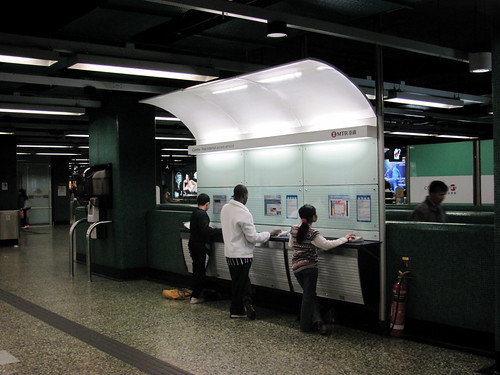
Free internet stations throughout the system
Hong Kong’s subway system has made a clear focus to integrate itself into people’s daily lives. There is WIFI throughout the system and free internet terminals. Advertisements also showed how the system cross-promotes itself with culture, focusing interest on transit by bundling fare cards with toys and event tickets. The best feature of integrating the transit system however is clearly the infamous Octopus smart card, first introduced in 1997. A testament to what PRESTO could do for the GTA, the Octopus card is ubiquitous in Hong Kong and you can use it to pay for a surprising array of situations. Many stores and food outlets, accept the card as a means of payment, I even used it to pay for the mounted binoculars at Victoria Peak. The Octopus card is now operated within its own company and continues to expand its uses in the city. The Octopus card allows for distance based fares and seamless integration with Hong Kong’s ferry’s, busses and trams.
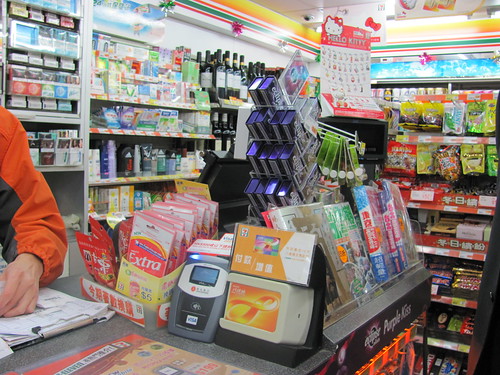
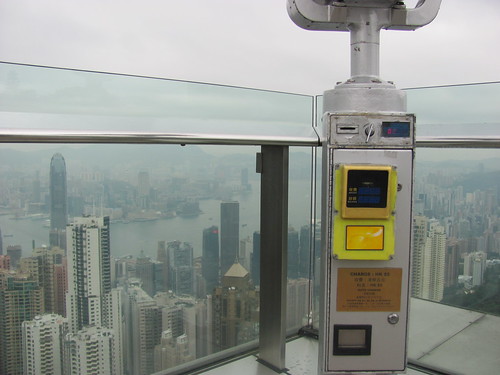
The Octopus card started on transit and is now used throughout the city
Hong Kong’s ferry and tram systems are impressive in their own ways as well. The heritage double-decker trams (referred to as the ‘ding ding’ by locals) are surprisingly rickety and do an incredible job of being both symbolic and highly functional. If your lucky enough to find one with some room to board, passengers enter through a turnstile at the back and pay when leaving. The historic Star Ferry accomplishes its dual roles as working transit system as well as a tourist attraction quite well. Seat backs on the ferry can be swung either way so that you can always face forwards.
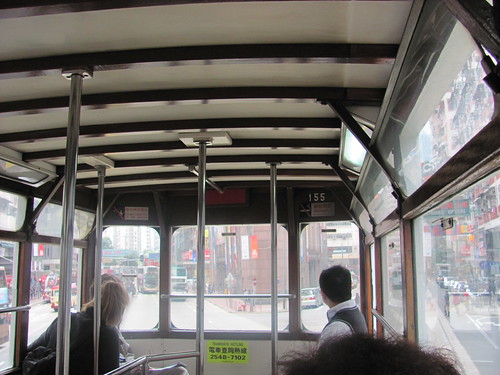
Inside one of the historic trams
What is most impressive about transit in Hong Kong however is how affordable the system is. Whatever you think about privatizing transit, in Hong Kong it has produced a system that is clean, efficient and affordable. Perhaps due to the competition with other transit operators, or ownership of adjacent profitable commercial properties, transit in Hong Kong will cost you surprisingly little. The tramway for instance, running through the heart of crowded Hong Kong island costs a flat rate of two Hong Kong dollars. At the current exchange rate that’s 27 cents Canadian. It’s no secret that this is a transit system to drool over.
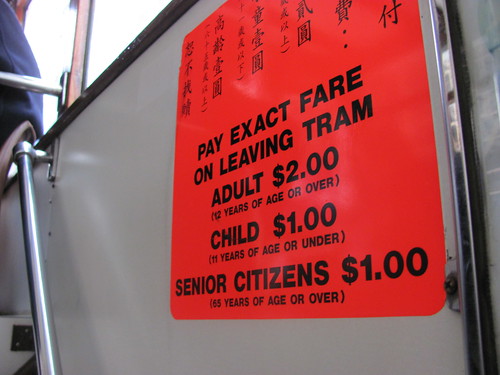
Proof of the unbelievably low flat fare on the Hong Kong Tram (two Hong Kong Dollars = 27 cents Canadian)
Top photo by Heather Champ, all other photos by Marcus Bowman


24 comments
Very unique?
I was there for 3 months during the summer.
As I lived in Hong Kong Island, the tram provided most of the transportation when I was on the north side of the island. Aside from reliable transportation, there was a very old Hong Kong feel about them too
Hong Kong Population Density: 6,076.4/km2
Toronto Population Density: 3,972/km2
One would hope given the density HK would have a good transit system…
When I first saw the subway stations in Hong Kong, I did indeed find them utilitarian – somehow, I expected more of them. During my visit, though, they really grew on me and I came to love their vibrant colours and understated yet consistent design.
Hong Kong is somewhat unique in that it’s geography makes for a city that is all high-density node – you get these incredible sudden shocks of agglomerations of intense development separated by mountains and water – which I would argue poses both unique problems and unique opportunities for transportation planners. Though you are not necessarily implying this, I doubt any kind of privatization of transit in Toronto would yield similar benefits.
I lived in Toronto for 7 years and am now studying architecture at the University of Hong Kong so I have experience with both the TTC and the transit system in Hong Kong.
Brian made a very good point about the much higher density of Hong Kong being an important factor. I remember trying to avoid the buses in Toronto mainly because they were just so inconvenient due to the long waiting time. It just wasn’t sustainable to run them at a frequent interval. In Hong Kong, however, most buses run with a headway of 5 mins, less during rush hour. It makes traveling around by transit just that much easier.
However, one thing that Toronto (well, Viva anyway) does better is its of real-time display of next bus arrivals. Sure, you still have to wait a while for the next bus to show up, but at least you can expect when it’ll arrive, whereas in Hong Kong, if traffic or something stalls the bus, you’re left wondering why it’s been 45 mins and the bus still isn’t here.
Ad wraps are a very common feature on the double-decker trams. I found the one advertising Subway (sandwiches) amusingly ironic.
Toronto’s stations may be also “colour coded”, but somehow I don’t find them as recognizable. Moreover, you might also have noticed that in Hong Kong you can see the name of the stations from inside the train even when it is very crowded. In Toronto, you often have trouble figuring out what station it is even if the station is empty.
The article mentions that the Octopus card “allows for distance based fares”, but this is a little bit misleading. The MTR has had distanced based fares even before the Octopus, and commemorative tickets are still magnetic cards.
I very much agree with the feeling about the exit signage. TTC seems to avoid putting directions to commercial buildings, and sometimes even non-commercial ones. I was shocked when the Sheppard line first opened and could find no signage to direct me to the nearby hospital (or IKEA, or Canadian Tire, landmarks that people are likely to recognize).
@Bob, one of the most surprising things for me about Hong Kong was how big the territory is, and the incredible dense nodes that people there called ‘suburbs.’ I think these nodes are probably the main service areas for the MTR. Hong Kong has a completely different transportation structure than Toronto that makes comparisons very difficult. Friends there told me that taxes on new cars are over 100%; as such the roads are dominated heavily by buses and taxis.
While you’ve focused on some aspects of Hong Kong, you are missing other huge aspects. First of all, there are the ubiquitous mini-buses, which only seat a very limited number of people and will tailor their stops to passengers. There’s also a myriad of different bus companies, and express bus companies which all jockey for customers. The amazing thing about Octopus is that is allowed the amalgamation of different PRIVATE companies’ transit to all operate using one card.
Simply put, there are so many different public transit transportation options in Hong Kong, that you can get basically anywhere using a combination of subway/train, bus and mini-bus even to your doorstep.
>In Toronto, you often have trouble figuring out what station it is even if the station is empty.<
is this serious?
@Leo
I hinted at the number of private operators in Hong Kong as being a strength. You’re right that these competing services provide excellent service, in some instances we found the bus a better alternative to the MTR, hence why the MTR has to keep prices competitive. I didn’t realize the purpose of those mini-buses until I visited the communities further up the mountain and saw the small winding roads. They truly are another really amazing aspect of the city.
Oh my God a place where private sector competition is allowed and works. Let’s try it with garbage services first before moving on to the TTC. It is time for Spacing readers to realize that the position of the Miller crowd against private delivery of services has more to do with their ideological support of Unions than the service provided as the TTC has so clearly demonstrated. When politicians are dependent on the support of the Public Servants for political success the Public interest is abused. The Carpenters’ union coming out for Smitherman when Miller/NDP are the ones who delivered to them a monopoly on much of Toronto’s public tendering is a perfect demonstration that the Building Trade Unions are more interested in their own economic self interests than progressive causes. Truly progressive parties like the Greens in Europe have realized that close association with Union causes is against their interests for the same reason. Again, I ask the question whether Spacing editors think a Building Trades monopoly over publicly tendered construction projects is good for Toronto’s future. The truth is that monopoly whether private or public is bad.
i wasn’t a transit or bike nerd when i spent a month in hong kong, but i do remember the clean subway, the incredible smog.
to me, it’s difficult to talk about any transit system, or any locale, as being good or humane while everyone chokes to death.
reminds me of all the big talk about how TEH AWESOME the big buses of Bogota and Mexico city are — they’re both right up there with Hong Kong as places you would go if you wanted to die of lung cancer.
I was in Hong Kong in the summer of 2009 and was very impressed by the ease of use and ubiquity of the city’s mass transit system.
Fascinating post and discussions. Thanks very one. I have only been to Hong Kong once many years ago. Next time I will pay much closer attention to their transit system. What I found most interesting is how the system combines various service providers, competing with as well as complimenting each other, while a single Octopus card keeps it all integrated from user’s perspective. Certainly something Torontonians should seriously think about.
Wow, in the top pick the trams/streetcars have their own right of way! What an amazing concept!
Unfortunately this was Not Invented Here by the TTC, so obviously would not work in Toronto…
Streetcar only lanes in town’d make TTC streetcars much more reliable, if politicians could ever grow the balls to implement & enforce it.
And if the TTC could manage a streetcar line, even those completely separated from traffic (we’re talking 510 Spadina & 512 St Clair – if anyone from the TTC’s reading this).
Perhaps Adam Giambrone, very busy with his mayoral run AND running the TTC, could take 2 minutes to read passengers’ posts on dreadful customer service & incompetent service management & labour relations.
How he could even conceive of running for Mayor when he can’t fix the 501 Queen car is really beyond reality.
Hey, Peter,
according to http://www.google.com/publicdata?ds=wb-wdi&met=sp_dyn_le00_in&idim=country:HKG&dl=en&hl=en&q=Hong+Kong+life+expectancy, Hong Konger’s life expectancy in 2007 was 82, over a year longer than Canadian’s. Their problem about smog is real for sure, which is not really surprising given the huge density. But if they are choking to death, that is surely a very very slow death.
What makes the MTR enterprise profitable is the revenue from real estate, not just the passenger fares. Real estate brings in half the revenue. An expansion of an MTR line means 60 story condo’s and a retail mall on top of the station that the MTR owns. Toronto by comparison has a few stations like this and has sold development space above High Park station, but for the most part subway stations are limited to a news stand or a convenience store. The TTC should raise more revenue selling property development rights, but they are hindered by their mandate of primarly providing transit service.
Not coincidentally, I hear, Hong Kong’s is also the world’s only profitable mass transit system.
The suburban MTR stations seemed to empty out into huge malls that I was told were owned by the MTR. I would be curious to know more about what revenue the TTC gets from air rights above its stations. In terms of the smog in Hong Kong, I think this has little to do with the city itself and a lot to do with the massive factories across the border in the rest of Pearl River Delta
What beautiful pictures..
Thanks for a great article about HK’s transit system, which I think is the most efficient in the world. Singapore and Taipei are a close second IMO, while Tokyo’s system is vast (but not as user-friendly, particularly if you can’t read Japanese).
The article already covers many details and various aspects of the HK transit system, while the comments provide additional perspectives and insights…so I’ll just add that my favourite aspects of the system there are:
1. The Octopus card, which I take with me on each visit to HK, is very very convenient not just for transit but purchases at an evergrowing number of stores, restaurants, etc. – a bonus for micro transactions especially since many of the lower denominations are heavy and thick coins. They are easy for visitors to purchase, use and even get a refund upon departing the city – special and/or limited editions of the cards entice even locals with existing cards to collect.
2. The trains are so clean! Spotless. Doesn’t smell of urine. The seats are metal rather than worn out, dirty fabric which trap dirt and who knows what else from your fellow passengers.
3. Love the exit signage. As a visitor to an extremely dense city, I would forever be lost and requiring directions if not for them (e.g., “the store you want is just outside of exit C”). Also, they are convenient for arranging meeting places (e.g., “meet me at exit B2”).
Hong Kong Population Density: 6,076.4/km2
Toronto Population Density: 3,972/km2
“One would hope given the density HK would have a good transit system…”
Comment by Brian
February 4, 2010 @ 11:11 am
—————————————————-
wow disappointed much? H.K has a wonderful transit system that can get you to any part of the city in minutes, they have a smart card that can be used for buses, subway, tram, ferry and eating. I think you need to go there to experience it before saying it should have a better transit system.
Anyways this article is great explaining all about H.K’s wonderful transit system & the octopus card, it makes me want to go back right now!
Another striking difference is that the HK subway system is completely automatized. Riders will never see a subway employee, except if there is a problem with their octopus cards.
So there are no angry shouting matches between union employees in ticket booths and passengers.